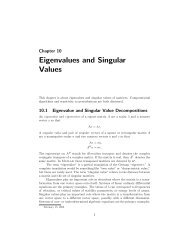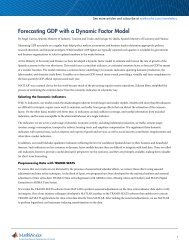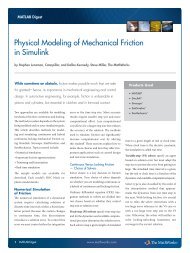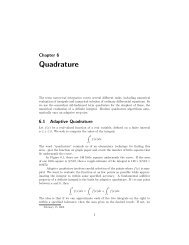Chapter 8 Exponential Function - MathWorks
Chapter 8 Exponential Function - MathWorks
Chapter 8 Exponential Function - MathWorks
Create successful ePaper yourself
Turn your PDF publications into a flip-book with our unique Google optimized e-Paper software.
Figure 8.3. Two plots of e iθ .<br />
When the Matlab plot function sees a complex vector as its first argument,<br />
it understands the components to be points in the complex plane. So the octagon<br />
in the left half of figure 8.3 can be defined and plotted using e iθ with<br />
theta = (1:2:17)’*pi/8<br />
z = exp(i*theta)<br />
p = plot(z);<br />
The quantity p is the handle to the plot. This allows us to complete the graphic<br />
with<br />
set(p,’linewidth’,4,’color’,’red’)<br />
axis square<br />
axis off<br />
An exercise asks you to modify this code to produce the five-pointed star in the<br />
right half of the figure.<br />
Once we have defined e iθ for real θ, it is clear how to define e z for a general<br />
complex z = x + iy,<br />
e z = e x+iy<br />
= e x e iy<br />
= e x (cos y + i sin y)<br />
Finally, setting z = iπ, we get a famous relationship involving three of the<br />
most important quantities in mathematics, e, i, and π<br />
e iπ = −1<br />
Let’s check that Matlab and the Symbolic Toolbox get this right.<br />
>> exp(i*pi)<br />
ans =<br />
-1.0000 + 0.0000i<br />
11
















